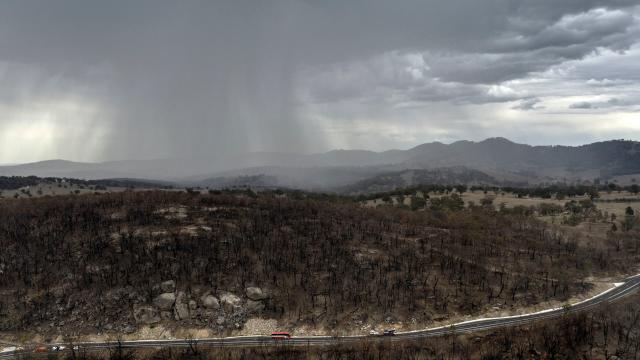Australia has been on fire. Perhaps you’ve heard.
After months of relentless heat and bone-dry conditions, parts of the continent are finally seeing much-needed rainfall. That could help quell the fires, but heavy downpours have also already led to debris flows, adding insult to injury in a country that really doesn’t need any more pain.
The shift in Australia’s weather began this week as more humid, tropical air finally began pushing over the continent. Thunderstorms and rain arrived on Thursday over Victoria and New South Wales, the two states hit hardest by bushfires. Attendees at the Australian Open in Melbourne opened umbrellas as opposed to dawning respirators, and Sydneysiders are preparing for more rain this weekend than they’ve seen in three months.
The weather pattern driving this shift is a big, old trough in the atmosphere replacing the ridge of high pressure that’s been parked over Australia. The high-pressure ridge essentially blocked rain from coming over the continent. The ridge also helped bake in heat and sunny skies for months on end, including one day where nary a drop of rain fell anywhere in the country and back-to-back days that were the hottest ever recorded for Australia. Those conditions stoked the flames, aided and abetted by climate change.
The trough swooping over the continent is ushering in rains from the southeast. Slow-moving storms have swept into the region, dropping two inches of rain a day with some areas seeing higher amounts locally as storms train over them, according to the Australian Bureau of Meteorology.
For firefighters, this is largely good news. High humidity helps tamp down fire activity, and rains can of course help put fires out or at least prevent them from spreading. Firefighting crews have been in a constant state of emergency for months, so any help from the heavens is a relief.
Keep that rain dance going! ???? – Pic: Robertson RFS. #nswrfs #nswfires pic.twitter.com/B5f66kclkt
— NSW RFS (@NSWRFS) January 16, 2020
But heavy rains also pose a risk when they fall on the denuded landscape. Fire- and drought-baked soil doesn’t do a great job absorbing water, which can lead to heavy runoff. Without trees, shrubs, and other vegetation to catch it, that can translate to landslides, flash floods, and mudflows. The Victoria State Emergency Service has already reported at least one road getting overrun with debris and a sinkhole opening up.
This form of weather whiplash is a prime symptom of climate change in Australia. Fire weather has grown worse in many locations in the country, but no place has seen danger increase more than the southeast region that’s been the epicentre of the fires this year, according to the Bureau of Meteorology’s 2018 State of the Climate Report. The same report shows the frequency of extreme heat has increased and the region has also dried. Yet even as southeast Australia has dried, the report notes that a “higher proportion of total annual rainfall in recent decades has come from heavy rain days.”
That’s how you can end up with a whiplash effect like what we’re seeing this week in Australia. It’s also something researchers have mudslides. So even though nobody is cursing the rain, it’s also a reminder that Australia and other places like it will need to prepare for increasingly volatile weather.
